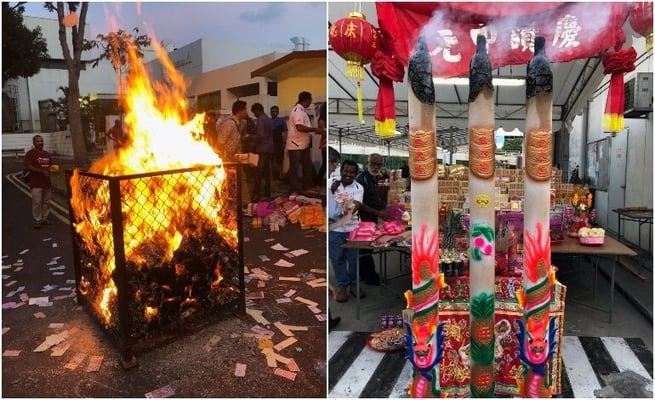Partying with the ghosts in Singapore

Many big cities around the world are referred to as ‘melting pot’, because people from many different parts of the globe make those cities their home, bringing with them their cultures, languages and cuisines. Our own Auckland city is one of the most ethnically and culturally diverse cities in the world.
However, the city-state of Singapore is in a class by itself. It has been a melting pot for hundreds of years – probably longer than any other world city that can boast of the ‘melting pot’ appellation.
Long before Singapore got its nationhood in 1965, people who came from China, India and several other regions in Southeast Asia have made it their home for hundreds of years, followed by immigrants from the world over, as it emerged as the global economic powerhouse that it is today.
Chinese, Indian and Singaporean cultures coexist cheek-by-jowl, particularly in its older quarters. And traditional festivals of these multiple cultures are followed and observed with enthusiastic and vigourous participation by most Singaporeans irrespective of their own cultural backgrounds.

We experienced one such festival when we were in Singapore last month, which is traditionally regarded as the ‘ghost month’ in Singaporean and Chinese cultures. The seventh month of the Chinese calendar is called the ghost month and the fifteenth day of this month is called ‘ghost day’. And that’s the event we were invited to participate.
The reverence for ancestors runs through several ancient cultures, especially in Asia and India, where parts of the calendar are earmarked for observances dedicated to ancestors and near and dear ones who have gone before us. In the ghost month, the dead are believed to visit the living and rituals are observed around this belief. Scholars trace the origins of this festival to Mahayana Buddhism.
Our Singaporean host annually observes the festival at their work premises with employees, clients and associates (some even from overseas) participating, which is followed by much feasting. As well as propitiating deities representing the departed with silent prayers and burning joss and incense sticks at a makeshift shrine erected just for the occasion, the event involves creating a huge bonfire, reminiscent of our Indian festival of Holi.

But unlike the Holi bonfire, you feed the ghost day bonfire with mock money, mock gold and mock-anything-of-value. The belief is that the more of this mock stuff you dedicate to the spirits, the more they will give you of the real stuff. So, each of us burned a few million, could be a few billion as well (who had the time to count?), of our mock money as the bonfire crackled and leapt up, its flaming tongues licking the skies as it were.
A fierce breeze blew and there was much cheering in the crowd. Our host said that high winds augured well as the more the wind, the more the embers rise into the sky, which is good luck for everyone. The twilight sky was filled with smoke, embers and pieces of mock notes wafting up like flattened confetti.
Eating and drinking followed the bonfire ritual, peppered with thanksgiving speeches, announcements and an auction that expanded to fill the whole evening. Money raised went into a fund that rolls over into next year’s festival.

Like many Singaporean establishments, our host’s enterprise is multiethnic and has small Chinese, Singaporean and Indian shrines on the premises. They’re well looked after and attended to by many of the employees, according to their faith. The Indian shrine housed an idol of Ganesha.
We do hope we’ve pleased the gods and the ancestors with all that mock money. Now to sit back, relax and wait for some real dosh to fall upon us from the skies!
Many big cities around the world are referred to as ‘melting pot’, because people from many different parts of the globe make those cities their home, bringing with them their cultures, languages and cuisines. Our own Auckland city is one of the most ethnically and culturally diverse cities in the...
Many big cities around the world are referred to as ‘melting pot’, because people from many different parts of the globe make those cities their home, bringing with them their cultures, languages and cuisines. Our own Auckland city is one of the most ethnically and culturally diverse cities in the world.
However, the city-state of Singapore is in a class by itself. It has been a melting pot for hundreds of years – probably longer than any other world city that can boast of the ‘melting pot’ appellation.
Long before Singapore got its nationhood in 1965, people who came from China, India and several other regions in Southeast Asia have made it their home for hundreds of years, followed by immigrants from the world over, as it emerged as the global economic powerhouse that it is today.
Chinese, Indian and Singaporean cultures coexist cheek-by-jowl, particularly in its older quarters. And traditional festivals of these multiple cultures are followed and observed with enthusiastic and vigourous participation by most Singaporeans irrespective of their own cultural backgrounds.

We experienced one such festival when we were in Singapore last month, which is traditionally regarded as the ‘ghost month’ in Singaporean and Chinese cultures. The seventh month of the Chinese calendar is called the ghost month and the fifteenth day of this month is called ‘ghost day’. And that’s the event we were invited to participate.
The reverence for ancestors runs through several ancient cultures, especially in Asia and India, where parts of the calendar are earmarked for observances dedicated to ancestors and near and dear ones who have gone before us. In the ghost month, the dead are believed to visit the living and rituals are observed around this belief. Scholars trace the origins of this festival to Mahayana Buddhism.
Our Singaporean host annually observes the festival at their work premises with employees, clients and associates (some even from overseas) participating, which is followed by much feasting. As well as propitiating deities representing the departed with silent prayers and burning joss and incense sticks at a makeshift shrine erected just for the occasion, the event involves creating a huge bonfire, reminiscent of our Indian festival of Holi.

But unlike the Holi bonfire, you feed the ghost day bonfire with mock money, mock gold and mock-anything-of-value. The belief is that the more of this mock stuff you dedicate to the spirits, the more they will give you of the real stuff. So, each of us burned a few million, could be a few billion as well (who had the time to count?), of our mock money as the bonfire crackled and leapt up, its flaming tongues licking the skies as it were.
A fierce breeze blew and there was much cheering in the crowd. Our host said that high winds augured well as the more the wind, the more the embers rise into the sky, which is good luck for everyone. The twilight sky was filled with smoke, embers and pieces of mock notes wafting up like flattened confetti.
Eating and drinking followed the bonfire ritual, peppered with thanksgiving speeches, announcements and an auction that expanded to fill the whole evening. Money raised went into a fund that rolls over into next year’s festival.

Like many Singaporean establishments, our host’s enterprise is multiethnic and has small Chinese, Singaporean and Indian shrines on the premises. They’re well looked after and attended to by many of the employees, according to their faith. The Indian shrine housed an idol of Ganesha.
We do hope we’ve pleased the gods and the ancestors with all that mock money. Now to sit back, relax and wait for some real dosh to fall upon us from the skies!









Leave a Comment